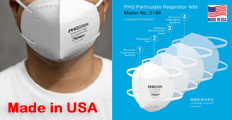



Find all of your laboratory and workplace safety supplies at Safety Emporium!
 Dermatosis |
 Glossary Index |
 Distance Units |
| MSDS Topics |
Free Sites | FAQ's | Regulations | Glossary | Software | Suppliers |
| Books | Forum | Poll | Fun stuff | Quiz | Store | |
| Understand your MSDS with the MS-Demystifier | Search ALL our MSDS info | |||||
Diaphoresis is a medical term for perspiration or sweating. The term usually refers to unusually heavy perspiration.
Hyperhidrosis pertains to sweating excessively and unpredictably, usually as a result of overactive sweat glands.
In July of 2004, the U.S. Food and Drug Adminstration (FDA) approved the use of Botox (botulism toxin) to treat severe underarm sweating. Botox is a prescription-only medication that is injected into the affected areas. It should only be used after your physician has ruled out other potential causes of the problem (such as hyperthyroidism; see the Medline link below) and treatments. Botox has since been used as a cosmetic that works by paralyzing facial muscles to reduce the appearance of wrinkles.
Some hazardous chemicals can cause excessive sweating. A classic example is metal fume fever caused by exposure to welding fumes.
Diaphoresis can appear in Section 11 (toxicological information) of a material's Safety Data Sheet, although most sheets will use the layman's term, sweating. Hyperhidrosis rarely, if ever, appears on an SDS.
Unusually heavy sweating could be from working in a hot environment or it could be a symptom of exposure to certain toxic chemicals. Additional symptoms such as palpitation, vertigo, prostration, or a general feeling of being unwell may or may not accompany your sweating. Either way, take a break and get some fresh air. If the symptoms persist, seek medical attention.
See also: dermal
Additional definitions from Google and OneLook.
Entry last updated: Sunday, July 10, 2022. This page is copyright 2000-2025 by ILPI. Unauthorized duplication or posting on other web sites is expressly prohibited. Send suggestions, comments, and new entry desires (include the URL if applicable) to us by email.
Disclaimer: The information contained herein is believed to be true and accurate, however ILPI makes no guarantees concerning the veracity of any statement. Use of any information on this page is at the reader's own risk. ILPI strongly encourages the reader to consult the appropriate local, state and federal agencies concerning the matters discussed herein.